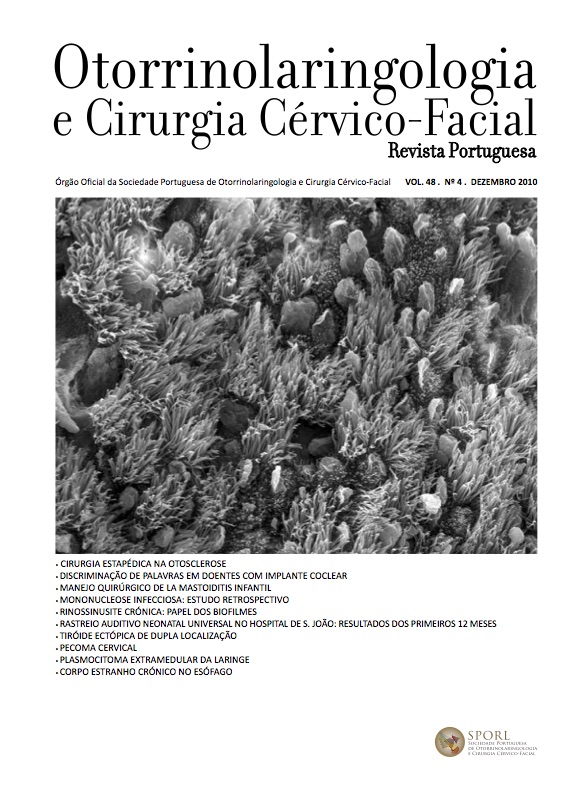Chronic rhinosinusitis: role of biofilms
DOI:
https://doi.org/10.34631/sporl.212Keywords:
chronic rhinosinusitis, biofilms, sinonasal mucosaAbstract
Chronic rhinosinusitis is a very prevalent disorder with significant societal impact and economic burden1,2. It is defined by a number of symptoms which last for more than 12 weeks and by inflammatory signs which are observed through anterior rhinoscopy and nasal endoscopy. Computed tomography imaging may also be used to document the disease1.
The pathogenesis of chronic rhinosinusitis remains largely unknown3. One of the possible etiological factors is the involvement of bacterial biofilms which has received much attention by many authors in the past few years4,5. Infections associated with these biofilms have proven refractory to prolonged treatment with antibiotics4,6. Biofilms have been implicated in several head and neck infections such as dental and periodontal disease, otitis media with cholesteatoma, typanoplasty tube otorrhea and chronic tonsillitis7. Recently, various authors have confirmed the involvement of biofilms in chronic rhinosinusitis2-7.
Furthermore, in patients with chronic rhinosinusitis associated with biofilms, structural alterations of the sinonasal mucosa are observed by electronic microscopy3,6. Various stages of severity have been detected from ciliar disorganization to total absence of cilia and goblet cells6. This paper presents a systematic review of the published medical literature in the Portuguese and English language. Current concepts of chronic rhinosinusitis and the role of biofilms in this pathology are discussed.
Downloads
References
- Fokkens W, Lund V, Mullol J. European Position Paper on Rhinosinusitis and Nasal Polyps. Rhinology. 2007; 45 (20): 1-139.
- Sanderson A, Leid J, Hunsaker D. Bacterial Biofilms on the Sinus Mucosa of Human Subjects with Chronic Rhinosinusitis. Laryngoscope. 2006 Jul; 116 (7):1121-6.
- Psaltis A, Ha K, Beule A, Wai Tan L, Wormald P. Confocal Scanning Laser Microscopy Evidence of Biofilms in Patients with Chronic Rhinosinusitis.
Laryngoscope. 2007 Jul; 117 (7): 1302-6.
- Bendouah Z, Barbeau J, Hamad W, Desrosiers M. Biofilm Formation by Staphylococcus aureus and Pseudomonas aeruginosa is Associated with an
Unfavorable Evolution After Surgery for Chronic Sinusitis and Nasal Polyposis. Otolaryngol Head Neck Surg. 2006 Jun; 134 (6): 991-6.
- Ha K, Psaltis A, Butcher A, Wormald P, et al. In Vitro Activity of Mupirocin on Clinical Isolates of Staphylococcus aureus and its Potential Implications in Chronic Rhinosinusitis. Laryngoscope. 2008 Mar; 118 (3): 535-40.
- Galli J, Calò L, Ardito F, et al. Damage to Ciliated Epithelium in Chronic Rhinosinusitis: What is the Role of Bacterial Biofilms? Ann Otol Rhinol Laryngol.
Dec;117 (12): 902-8.
- Hassan H, Ramadan M, Sanclement J, Thomas J. Chronic Rhinosinusitis and Biofilms. Otolaryngol Head Neck Surg. 2004 Jun; 132 (3): 414-7.
- Brook I, Bajaracharya H, Hinthorn D. Chronic sinusitis - eMedicine Specialties. Last update: Jun 2009. Available from: URL: http://emedicine.medscape.com/article/232791-overview.
- Lund V. Therapeutic Targets in Rhinosinusitis: Infection or Inflammation? Medscape J Med. 2008; 10(4): 105.
- Davies DG, Parsek MR, Pearson JP, Iglewski BH,et al. The Involvement of Cellto-cell Signals in the Development of a Bacterial Biofilm. Science. 1998 Apr 10; 280(5361): 295-8.
- De Beer D, Stoodley P, Roe F, Lewandowski Z. Effects of Biofilm Structure on Oxygen Distribution and Mass Transport. Biotechnol Bioeng. 1994 May; 43(11):1131-8.
- Xavier J, Picioreanu C, Rani S, Loosdrecht M, et al. Biofilm Control Strategies Based on Enzymic Disruption of the Extracellular Polymeric Substance Matrix – A Modeling Study. Microbiology. 2005; 151: 3817-32.
- Ghnnoum M, O´Toole G. Biofilm Antimicrobial Resistance in Microbial Biofilms. Washington DC: ASM Press. 2004; 14: 250-68.






